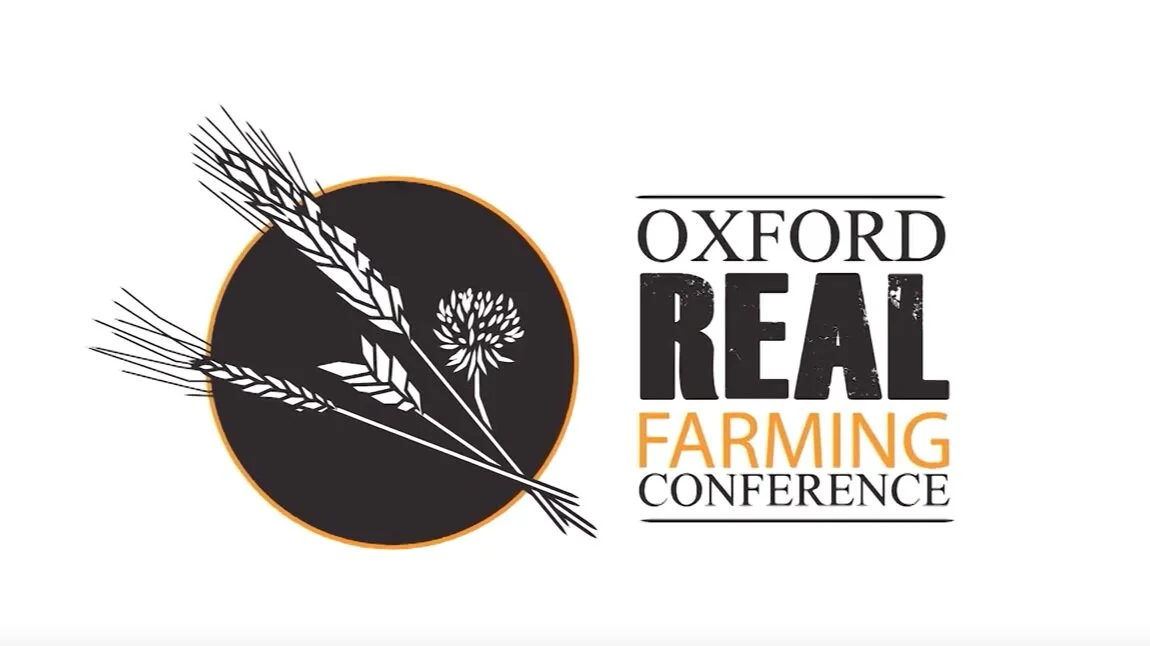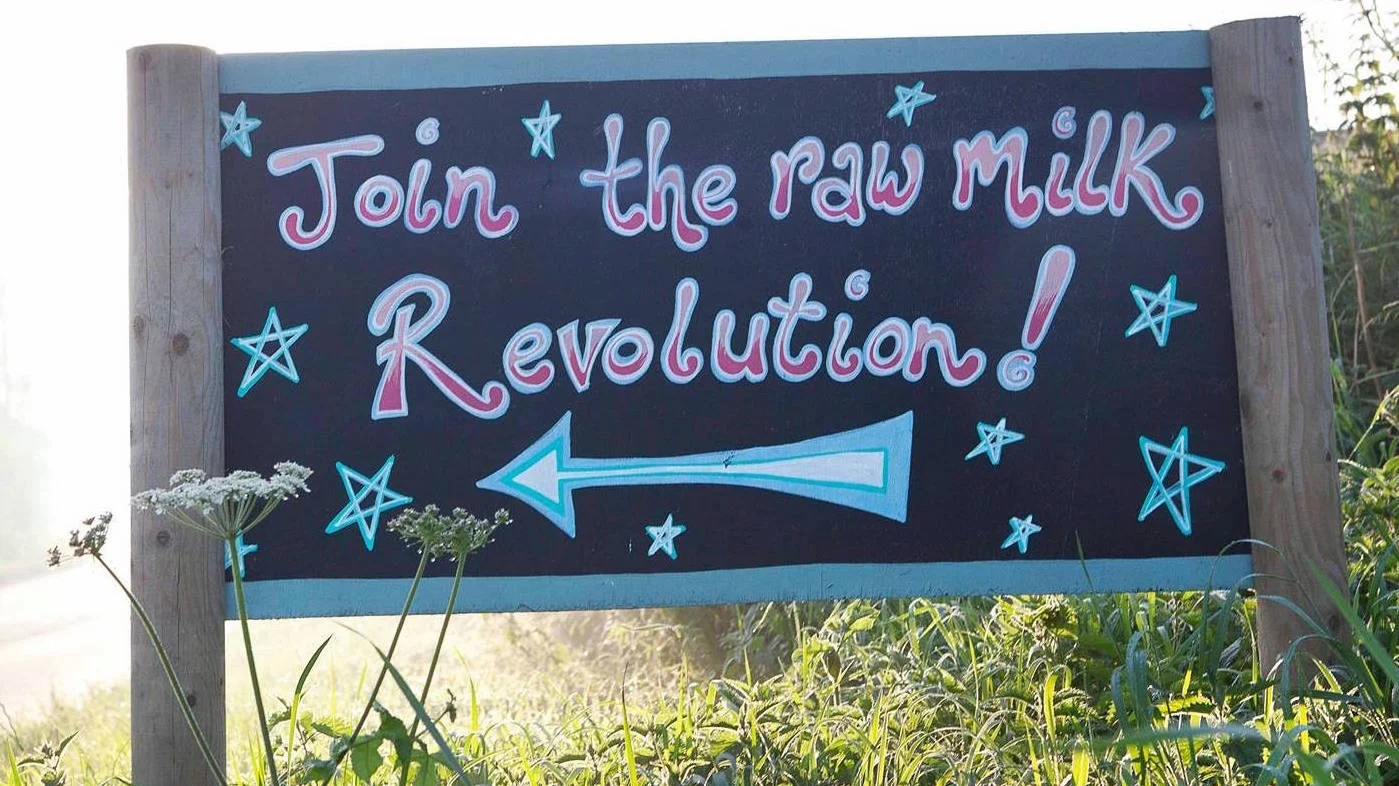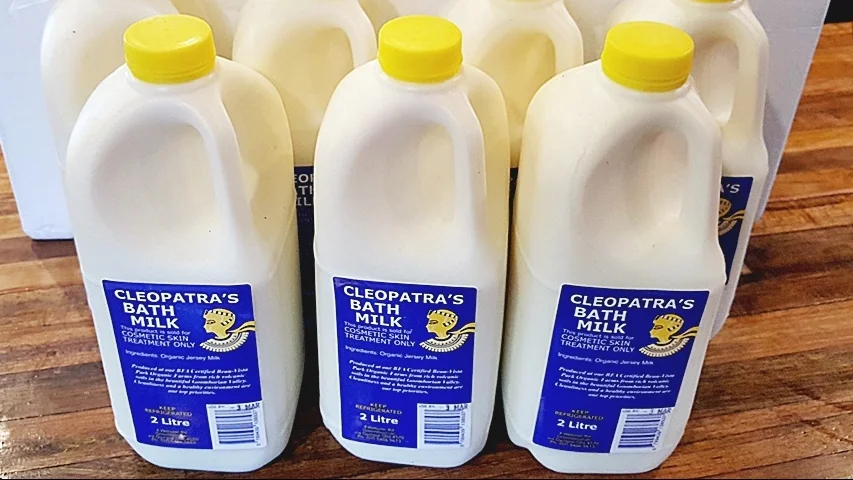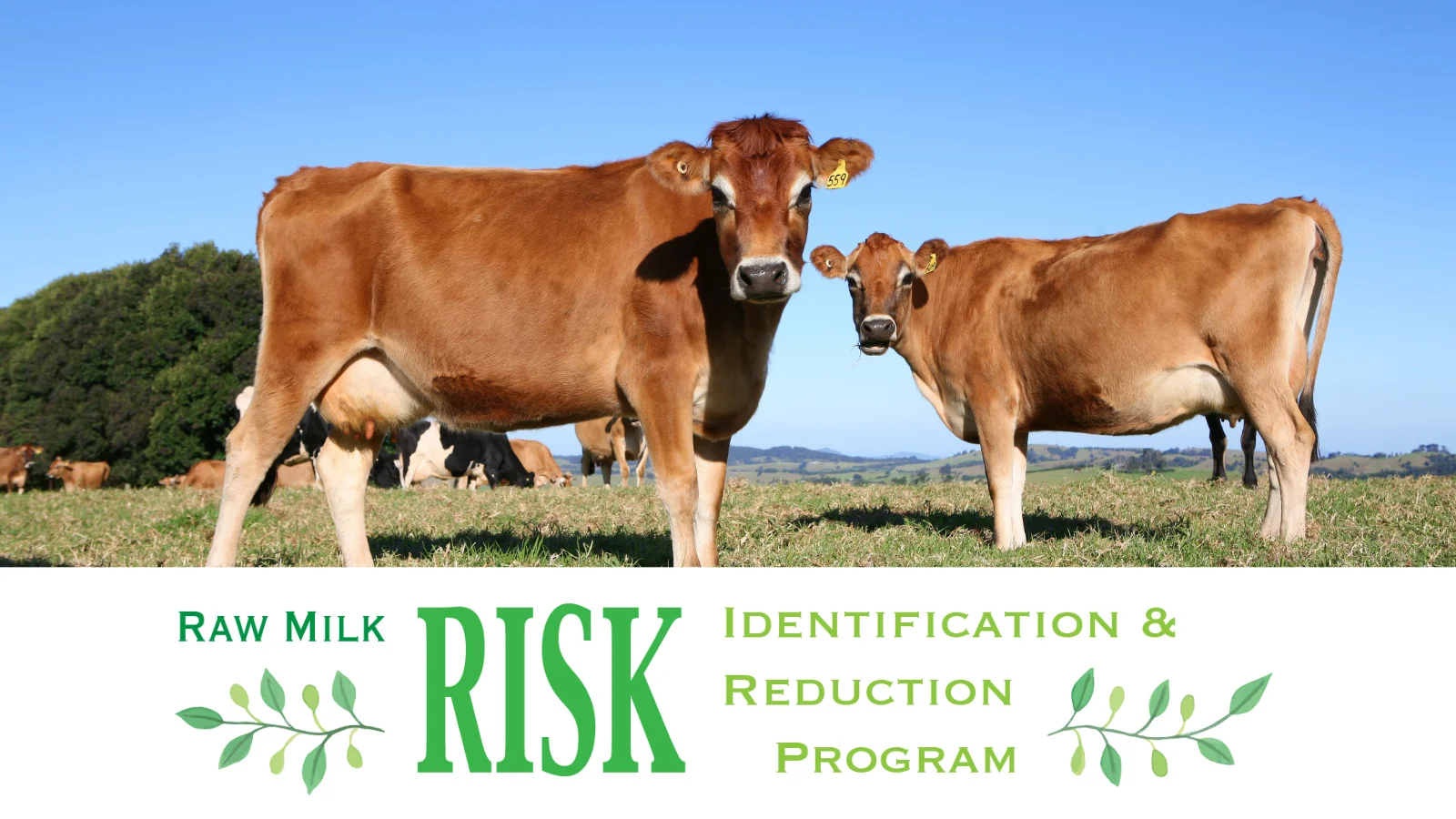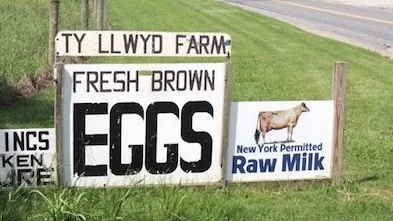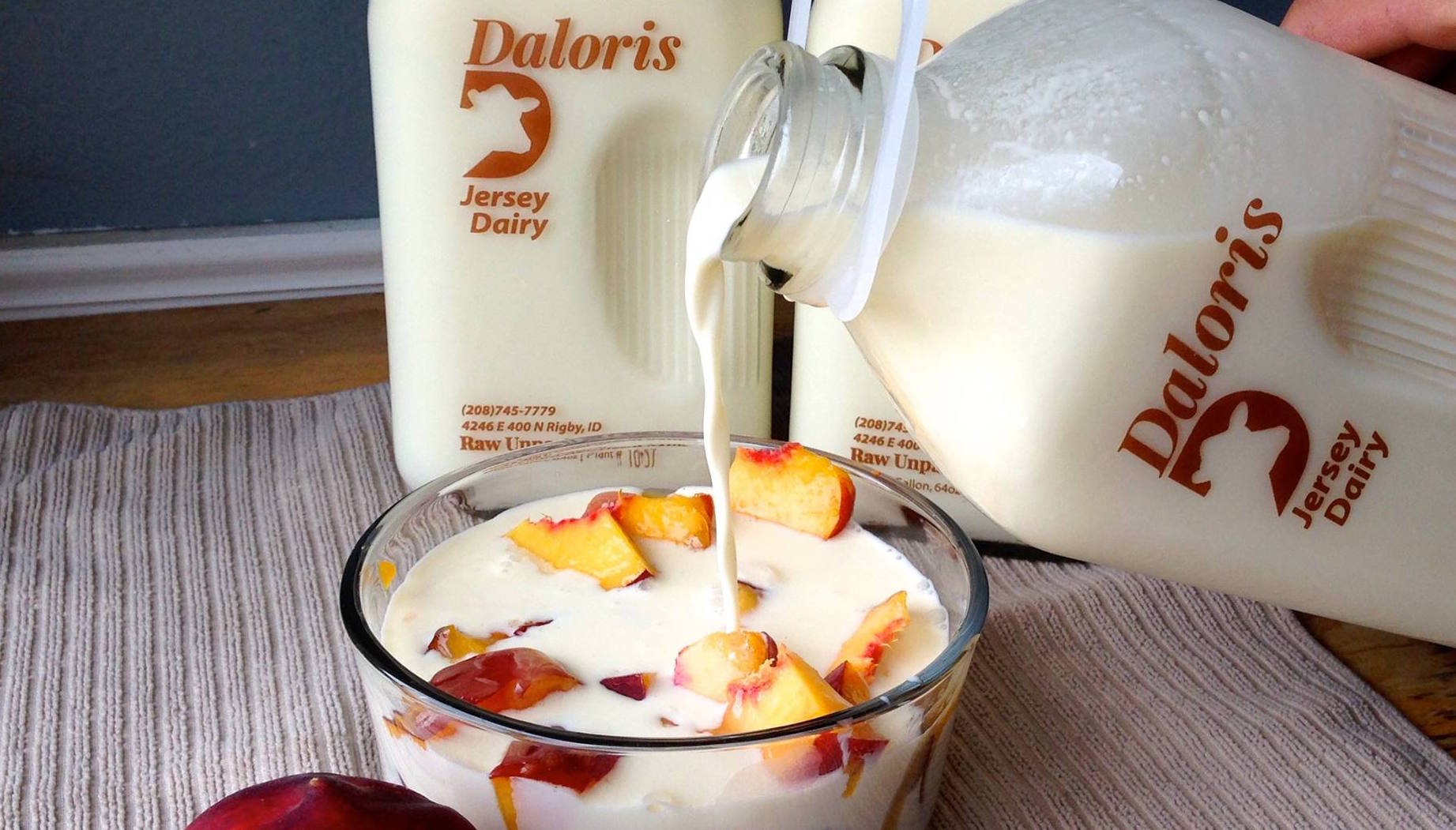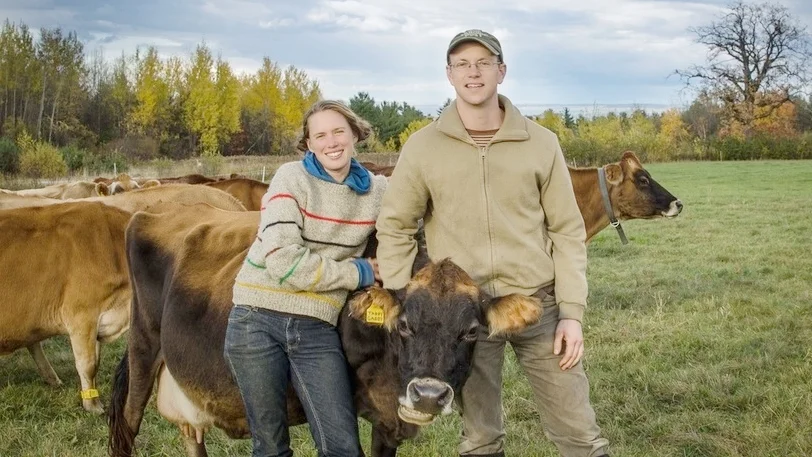Video: Sally Fallon Morell, author of 'Nourishing Traditions', calls for a return to 'real milk'. An Australian produced video by www.mindd.org, 2 minutes
We still get asked: what is raw milk?
It is apparent that there is a gap in understanding about the different ways in which milk is processed, and what goes into producing the final product. We still get comments on the ARMM Facebook page that suggests that some consumers don't know the difference between pasteurisation and homogenisation, or what standardisation entails. Or some don't understand why raw milk has a cream top, or why it has a yellowish colour. Some people still don't understand the need for a regulated raw drinking milk industry, as in England & Wales, Northern Ireland and New Zealand.
There is also a new milk product marketed as ‘Cold Pressed raw milk’, which comes from yet another food production system called High Pressure Processing (HPP), learn more about that towards the end of this article. This is NOT the kind of raw milk we advocate for. All of this highlights the need for more education, so people can become discerning, and realise the value of REAL raw drinking milk produced from healthy, grass-fed animals. This blogpost is an attempt at arming people with knowledge, while keeping it practical, without going into too much detail.
1 in 6 Australians are saying goodbye to milk
according to a June 2016 study by the CSIRO and the University of Adelaide. The study found three-quarters were eschewing (pasteurised) dairy to relieve symptoms like bloating, stomach cramps and wind. Australian children now have the highest rate of food allergy in the world according to this article. Melbourne is considered food allergy capital of the world (source). According to Mark McAfee (chairman of the Raw Milk Institute), pasteurised milk is allergenic and lactose intolerance causing. Processed milk is considered the number one allergenic food in the USA.
Many raw milk consumers report that they have no trouble digesting or tolerating raw milk produced for human consumption. They report that they find relief from medical conditions like allergies and asthma. Many say they simply thrive on it.
What is raw milk not?
- not homogenised
- not pasteurised
- not heat treated
- not cold pressed
- not cold pasteurised
- not processed
- not factory farmed
- not imitation food
- not artificial or fake
- no chemicals
- no additives
- no preservatives
- no hormones
- no adulteration
- no genetically modified organisms (GMOs), because they may pose food safety risks
What is raw milk?
Raw drinking milk comes from animals like cows or goats that are allowed to pasture on green grass or hay. Contrary to popular belief, pasteurising milk is unnecessary if the cows are clean, healthy and allowed to enjoy a natural pasture-based diet, and the milk is from a dairy where the hygiene and testing is spot on. However, raw milk have become a complex issue since the industrialisation era circa 1800, resulting in the need for certified raw milk. Certified Milk was understood to mean raw milk that was very carefully produced and kept clean. It is the kind of milk that Dr. Coit worked to make available to feed to infants and children in hospitals in the late 1800s. It is also the kind of milk given to patients in hospitals in Germany nowadays.
Not all milk can be drunk raw today. Large tankers bring milk collected from countless dairies to be co-mingled at the factory for processing. If just one dairy's milk has a pathogen (bacteria that are potentially harmful to health) in it, it contaminates all the milk. Therefore, pasteurising that co-mingled milk is vital to keep everyone safe.
However, small dairies who sell their milk to consumers directly, are able to take the necessary care to produce a top quality raw milk, where pasteurisation is not necessary. The Raw Milk institute say that there needs to be a clear distinction between milk that is meant to be consumed raw, and raw milk that is meant to be pasteurised. They involve two different sets of production standards, different values and different outcomes. For more information read: Two kinds of raw milk.
Certified raw milk has made a comeback in popularity in recent years, with direct farm-to-consumer sales. After milking under hygienic care, raw drinking milk is typically filtered, chilled, tested, bottled and sold to the consumer, either packaged in a bottle or via the raw milk vending machine. These milk dispensers have become very popular in Europe, England and New Zealand.
With industrialisation some raw milk became unsafe. This book tells the story.
Why a regulated raw milk industry?
Raw drinking milk has to be produced specifically for human consumption today from healthy, grass- and hay fed animals because of the strong opposition and prejudice against it in countries with a strong dairy industry. No other food is held to perfect safety standards nearly as much as raw drinking milk. In fact, all other food is allowed to have a manageable risk, including food that have a less perfect safety profile than carefully produced raw drinking milk. It has been singled out and targeted by biased Food Safety, Health authorities and others for decades. Fortunately, the raw milk revolution has brought positive change in many places. Raw drinking milk is in the same category as foods like seafood, oysters and raw chicken, which have to be handled with care. Yet all raw cow’s milk is treated as potentially deadly by authorities in Australia, who still maintain an anti-raw milk stance despite raw goats milk being legal in four Australian states. Raw milk cheese production was also legalised in 2015. Many people have gotten sick or died from foods like cantaloupe, ice cream, salad greens, leafy vegetables, even pasteurised milk, yet we don't see authorities act to curb the availability of those foods with the same over-reaction (more).
There is a clear bias and agenda against raw milk in particular.
The large commercial milk system has put many farmers out of business, but many who sell raw drinking milk directly to the consumer can get a good income. They get a lot more money per litre than they ever will from processors. Industry knows that raw drinking milk is a superior, high profit, high demand product. Many different industries see it as competition. That is why there are paid lobbyists dealing with government to keep raw milk legalisation efforts at bay, and other authorities advising against it. Food safety is often the reason given for targeting it, and the excuse for raw milk laws that seem over the top. However, the result of raw milk prohibition is often the same: commercial advantage for large scale food processors (example here). Big food processors want to be the only winners in the food industry, and they don't want competition from small-scale farmers. There is much evidence to suggest that raw milk prohibition is really about business…
History has shown that authorities and the media world-wide are very quick to link illness to raw milk. In the video below, Sally Fallon Morrell say that public health officials choose their words very carefully when they talk about raw milk. They use words like potential, likely and linked. Many raw milk producers in the USA have had their reputations ripped to shreds over incidents where raw milk was blamed for causing illness. Sometimes there was no proper evidence, or the origin of illness was later found to be inconclusive, but by then the damage was done.
According to lawyer Pete Kennedy: “Where raw milk is concerned, the FDA has an agenda apart from protecting the public health. The agency wants to restrict and discourage the sale of unprocessed dairy products. This will have the effect of denying freedom of choice.” Sally Fallon Morell says “Every time there is a possible connection between illness and raw milk, government officials issue dire press releases and call for bans on raw milk sales.” “However, these numbers fail to justify the government opposition and prove what we’ve known all along, that raw milk is a safe and healthy food.”(source)
Video: Harvard Food Law Society hosted a debate on the legal, nutritional, and safety aspects of raw milk. For more information about the Food Law Society, including each of the presenters' powerpoints go to www.foodsoc.org. Pro raw milk speakers Sally Fallon Morell speaks at the 5 minutes time marker and David Gumpert at 20 minutes.
Having a regulated raw milk industry can protect both producer and consumer.
Production standards and a regulated industry means there are proper testing protocol enabling the raw milk producer to show evidence that their milk is not to blame. Raw milk regulation means production is carefully managed under food safety plans, risk analysis, advanced testing protocols and careful handling and distribution. This results in management of risk and a dramatic reduction of risk. This may seem like over-regulation to some, and from a certain perspective it is, but it has become a legal avenue for raw milk industries to thrive (more).
Audio: Steven Hook from Sussex, UK is interviewed by ABC Rural during his 2016 visit to Australia. He discusses raw milk production and regulation. Steve has been selling raw milk for human consumption directly to the public since 2007 (source).
Video: ARMM hosted the Raw Milk Panel Discussion night on 17 June 2015 in Melbourne for the public to come and meet the farmers, healers, scientists and chefs who advocate for raw milk and get their questions answered. Event details here.
The process of producing raw milk for human consumption involves a lot more care and testing for pathogens than simply producing conventional pasteurised milk.
Many dairy farmers in Australia drink their own raw milk directly from the vat and do not understand why ARMM advocates for a regulated raw milk industry with all its implications for farmers. Here it is worth considering the many Australians living in the city who have never drunk raw milk. They may not have the same developed immunity to farm microflora in raw milk as a farmer, or a regular raw milk consumer. Mark McAfee says that for a small number of newcomers to carefully produced unpasteurised milk there may be a brief adjustment period, to allow the good bacteria to colonise the gut. These are the people who need top quality raw drinking milk. Another reason why raw milk can be safe, but not perfect, is because the immune system of people consuming the Standard American Diet is so weak. Mark says that a pathogen that would not normally make a healthy person sick, can make a person who has this tremendously depressed immune system very sick (source). Bacteria drives our immune system, but the overuse of antibiotics, sterilised foods, pasteurisation, irradiated foods, and preservatives bring on inflammation and higher instances of autoimmune disorders like Crohn's disease and arthritis, as well as a host of allergies (source). Also read Gut Microbiota and the Immune Compromised for a deeper understanding. Also see the article Friend or foe? to learn how beneficial bacteria have been demonised.
For the continued success of a raw drinking milk industry in a competitive business environment that is heavily opposed to it, regulation or at least best practice production standards are vital. To reiterate, no food can be produced a 100% safe, but overseas examples have shown that unpasteurised milk can be produced as a low risk, pathogen-free product. In regulated raw milk systems, immune compromised groups are often warned not to consume raw milk. It is also important to note that not all regulated raw milk systems are equal. Some interests relish in blaming the raw milk when problems arise, when system architects may be to blame for a system that is inadequate, or leaves room for potential error. Raw milk systems must have the right set of strict controls, but must also be sanitised from over-the-top, unnecessary and overly cost-prohibitive rules. Production systems must be fair. No shenanigans.
Raw Milk herd shares
If a regulated raw milk industry cannot be achieved, then different models like herd sharing can work well too. Under this, a voluntary system is instituted where production standards and food safety plans ensure a quality raw product. The USA has many states (with no or little regulation for raw milk sales) where this is a form of self-regulation by grass-roots groups. It can work well. Mark McAfee talks about it in this video clip. There is a variety of self-regulation systems in America such as the Raw Milk Producers Association of Colorado (RMAC) or the Oregon Raw Milk Producers Association (ORMPA). Read more: Fair Regulations and Production standards for Raw Milk.
What can certified raw milk look like in Australia? Certified raw milk in Australia.
For examples of overseas regulated raw milk industries: Raw milk around the world.
FYI: RDM refers to Raw Drinking Milk in the industry.
A yellow cream line?
The thickness of the cream line in raw cow's milk is an indication of its value because the cream is the most nutritious part of the milk. The liquid beneath the cream line is mostly water. Jersey and Guernsey cows produce milk with a high butterfat content that is highly prized. According to Mark McAfee in this video, one of the follow-on consequences of homogenisation is the ability to hide the cream content of the milk from the consumer. It enables industry to skim off the cream, and in turn cheat the consumer without them knowing it. With raw milk it is impossible to hide the cream content, as the cream line will naturally settle at the top if left undisturbed for a few hours. Note that if a dairy sells cream or butter, some of that cream is skimmed off to produce those products, but there is often still plenty of cream in the milk, otherwise customers complain.
The colour of the cream is also a quality giveaway. A yellow colour indicates a high beta-carotene (vitamin A) content. This means the cows enjoyed a diet of rapidly growing green grass. This milk is more nutrient dense and highly valued in traditional cultures, according to the work of Dr. Weston A. Price.
Note that some say Jersey cows make a more yellow coloured milk. In addition, goat’s milk is naturally 'homogenised', so the cream stays mixed in the milk, and doesn’t separate into two layers the way cow’s milk does. So don’t be concerned if you can’t find the cream on top of goats milk, it’s in there.
What does research say about raw milk?
Science out of Europe shows that drinking raw milk reduces asthma, allergies, colds and ear infections. It is not the farm life, exposure to cats or dogs, or other factors, but the raw milk itself that is beneficial. The Parsifal study makes that clear. One of the lead authors of the Pasture study said: "It means there is additional new evidence that raw milk is a protective agent in infectious diseases in young children.” It was found that the milk in its pure, raw, unobstructed form is superior when it comes to immune-boosting nutrition.
Some of the studies out of Europe:
and
New Science Confirms that Drinking Raw Milk is Remarkably Safe
Raw Milk Overpowers Conventional Milk In Reducing Risk Of Numerous Infections
This document from the B.C. Fresh Milk Project shows a measurable effect that Raw Milk Institute training has on the quality of raw milk. The science shows “up to 24% of milk intended for pasteurization contains pathogens, whereas carefully produced raw milk is very unlikely to contain pathogens”.
Why raw milk?
What does raw milk sales mean for farmers?
Dairy farmers producing certified raw milk can get far greater prices per litre than they would from processors. Raw milk sales direct to the consumer is a profitable, niche market for the family farm. Both farmer and consumer become better informed as direct sales invite trust in quality and allows for the farmer to get feedback and social interaction around the product. Consumers care about the wellbeing of the farmer, the animals and the quality of their raw dairy.
What does raw milk access mean for consumers?
Many consumers prefer locally sourced food. Raw milk consumers are typically well informed about nutrition and they want to make informed choices to buy raw milk. They are often willing to go to great lengths for access. Consumers often want to influence the farmer on how the food is produced. They are willing to pay for alternative food production systems, like 100% pasture-raised, cow with calf dairying, milk from glass bottles, regenerative practices that heal the soil and restores nutrients and quality etc.
Source: The truth about pasteurisation Click on image for larger view
What is pasteurised milk?
Mother Nature is very clever when it comes to the digestibility and safety of raw milk. The milk itself contains the enzymes needed to digest it and components to protect it from contamination. Natural occurring enzymes, milk proteins and bacteria are warped and distorted by pasteurisation, so that the body ends up recognising them as foreign, mounting an immune response to expel it from the body. This is just one of the reasons why people have trouble with pasteurised milk.
Pasteurisation is the common standard of milk treatment whereby potential pathogens and bacteria are killed. First the milk is heated to high temperatures and then it is cooled down, before the milk is bottled and sold to the consumer. There are various pasteurisation temperatures, with the higher end called ultra pasteurisation (UHT) to sterilise the milk and extend shelf life. Unfortunately the pasteurisation process denatures some nutrients in the milk making them bio-unavailable (see here), alters the taste and destroys the enzymes needed to digest the milk. Pasteurised milk is losing its appeal, with more people simply not buying it anymore.
Some raw milk drinkers in Victoria have switched to low temperature pasteurised milk after raw 'bath milk' disappeared from shelves. For more information read Dr. Axe's article: The truth about pasteurisation and A campaign for Real milk's article: Raw vs Pasteurised milk. The visible effects of processing on milk can be seen here thanks to microphotography.
What is homogenised milk?
Homogenisation is the process of taking milk at the milk processing plant, and forcing it at high pressure through fine mesh to break up the fat globules in the cream, so they remain suspended throughout the milk for long periods of time. The process prevents the cream from separating into a visible cream line, and instead leaves a creamy layer on the top where some fat globules come together. Homogenised milk has the same colour and look right through. Microphotography shows there is quite a difference before and after.
What is standardisation of milk?
Most milk that is processed at large processing plants are standardised nowadays. The cream is skimmed off to make other high value products, like cream, ice cream, cheese, butter etc.
Jersey cows can produce milk with 5.25% cream, but after some of it gets removed, say 1/3 of the cream, the leftover can still sell as ‘whole milk’ even though there is less cream. Holstein cows (the black and white cows) produce less cream, so if the majority of milk co-mingled at the factory is from holstein/friesian cows, the cream quantity is even less. This is acceptable for industry. Today, standardisation means the milk is deconstructed down to the basic level, like permeate.
The invention of ultra-filtration uses membrane filters and enables factories to separate milk components down to the molecular and ionic levels. Some retentate (fat, protein and solids) is added back to the permeate (white water). This allows factories to standardise both the fat and the protein, read more here.
Many don’t understand the details, but it is when supermarkets also sell whole, unhomogenised milk from independently processed small-scale dairies, that consumers notice differences. Many consumers and farmers are unaware, which is another reason why big business doesn’t want local food economies. The direct farm-to-consumer relationship inevitably reveals these realities.
What is 'Cold Pressed Raw Milk'?
Cold Pressed Raw Milk is a new product that was introduced to the market in Australia June 2016 by Made by Cow. It is raw milk that is treated with a process called high pressure processing (HPP) by submerging the milk - while in the plastic bottle - under titanic pressure, like that experienced 60 km under the ocean. This kills any potentially present pathogens (and good bacteria), making it safe to drink according to NSW food authority. We do know that milk proteins are fragile and easily damaged, so it is anyone's guess what happens to milk that undergoes the kind of pressure experienced under the deepest ocean for several minutes. HPP is not a new process, but it is still a very expensive one. It’s also called ‘cold pasteurisation’. The NSW food authority calls this product 'highly processed' and emphasises that this is not really raw milk. There are no laws prohibiting Made by Cow from putting the words 'raw milk' on their product.
According to this Stuff article, a 120 page MPI New Zealand report released in May 2019 is not optimistic that HPP could replace pasteurisation of milk yet. It reviewed 73 scientific publications and various regulatory websites and "failed to identify sufficient evidence" that HPP was suitable for milk. HPP is a small batch process, while pasteurisation happens on industrial scale, said Dr Mohammed Farid, a professor in the Department of Chemical and Materials Engineering at the University of Auckland.
For more information on the impact HPP has see this review: High Pressure Processing and Its Impact on Milk Proteins: A Review. The abstract reads: “High pressure processing (HPP) is a non-thermal or cold pasteurization technique to preserve various food products. High pressure in range of 100–1000 MPa affects size, shape and conformation of various milk proteins. Casein micelles having primary conformation are not affected under low pressure, but disintegrate at high pressure (300 MPa). β-lactoglobulin (β-lg) is one of the most pressure-sensitive proteins and α-lactalbumin (α-la) is one of the most pressure resistant. Bovine serum albumin, lactoferrin and immunoglobulins are not much affected by high hydrostatic pressure (HHP). It has been observed that to achieve the shelf-life of thermally pasteurized milk of 10 days at 10 °C, a pressure treatment of at least 400 MPa for 15 min or 500 MPa for 3 min is required.”
Also see: Effect of high pressure processing on the safety, shelf life and quality of raw milk and HPP: Equipment, Trends and the Science Behind the Technology
We have had lots of discussions about this product on our social media pages over the years. The feedback we get is that some consumers feel they have been deceived, when they discover that this product is from a different food production system, than the kind of raw drinking milk that we advocate for. For more articles on ‘cold pressed raw milk’, see the Related Articles section at the bottom of this article.
Raw milk quotes:
“It is irresponsible for senior national government officials to oppose raw milk, claiming that it is inherently hazardous. There is no justification for opposing the sale of raw milk or warning against its inclusion in the diets of children and adults.” Dr. Ted Beals USA
“Every time there is a possible connection between illness and raw milk, government officials issue dire press releases and call for bans on raw milk sales. However, these numbers fail to justify the government opposition and prove what we’ve known all along, that raw milk is a safe and healthy food." Sally Fallon Morell, Maryland, USA
"If you are a raw milk advocate I encourage you to support your local dairy farmers and their family businesses in this process of modernisation, while recognising the important role of regulation in providing safe raw milk to consumers." Dr. Ron Hull Australian microbiologist
"Raw milk is a beautiful product: very healthy, very natural, very healing in its properties. When it's coming from animals that are healthy, that are kept clean, that are allowed to roam freely and allowed to be fed on pasture. Without introduction of anti-biotics, pesticides and other intervention strategies, you are going to end up with a product that’s absolutely perfect." Dr. Kristian Ronacher Australian ex-CSIRO microbiologist and health consultant
Image: a Raw Milk Institute poster
Video: A campaign for Real Milk with Sally Fallon Morell. Download the Powerpoint presentation here.
Video: featuring Dr. Ron Hull, Dr. Ted Beals, Mark McAfee and Sally Fallon Morell.
Related Articles:
What is raw milk?
The facts about real raw milk - Real Milk.com
The Truth about Raw Milk with Mark McAfee from Organic Pastures
A campaign for real milk powerpoint presentation
Government data proves raw milk safe
Raw Milk Institute Headquarters (RAWMI) Visit
Common Standards by the Raw Milk Institute
Late 1800’s New Jersey Hospital Provided Certified Raw Milk
New Science Confirms that Drinking Raw Milk is Remarkably Safe
No Deaths in 38 Years From This Raw Milk -- So Why is it Condemned?
Particle Physics Might Make Your Raw Milk Safer to Drink
Pasteurisation:
The Truth About Pasteurization
Cold Pressed Raw Milk:
'Closest thing to raw milk' to be sold legally for the first time in Australia, start-up says
'Cold-pressed raw milk' method wins regulatory approval
“Cold-pressed raw milk” highly processed, says NSW Food Authority
Made By Cow milk label’s raw truth exposed
What is high pressure processing (HPP)?
Video: How High Pressure Processing works to give food a longer shelf life
1 in 6 Australians are saying goodbye to milk:
Australians are increasingly avoiding dairy foods for all the wrong reasons









